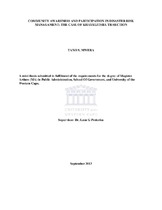| dc.description.abstract | Community participation and awareness in disaster risk management is widely recognized as a cornerstone for disaster risk reduction and effective response and recovery strategies. This goes parallel with the world paradigm shift form relief and response to prevention and mitigation. There is gradually increase of fire and floods in informal settlements and Khayelitsha TR- Section in particular. “From 1995-2005 more than 8554 informal dwelling fire incidents occurred in Cape Town alone, affecting 40 558 households and around 160 000 peoples" (DiMP, 2008). And in 2007 alone floods affected 8,000 households and 38 residents in the Cape Town informal settlement of Khayelitsha; Bongani TR-Section and Phillippi; Phola park (Bouchard et al, 2007). This study analyzed community participation and awareness mechanisms in disaster risk management, its implementation, practice and effectiveness, following the promulgation of the Disaster Management Act No 57 of 2002, taking Khayelitsha TR- Section as a case study. In order to achieve the stated objectives, the researcher employed a combination of both qualitative and quantitative research paradigms. In qualitative context semi-structured interviews were conducted with the key informants disaster management officials and Khayelitsha TR-Section ward structure officials. Quantitative method, 100 structured questionnaires were distributed to Khayelitsha TR-Section residents. Using Khayelitsha TR- Section as a case study the thesis argues that despite the enabling policy and resource allocation for community participation and awareness its implementation proved to be a failure. Most of the mechanisms directed by the act are not implemented and those implemented its practice is not effective to achieve its stated objectives of risk reduction and effective response and recovery to disaster incidents. The study reviewed literature and theories of community participation and awareness in disaster risk management. It reviewed and outlined a policy framework and institutional arrangement for community participation and awareness in disaster risk management in accordance with the Disaster Management Act (No 57 of 2002). It further determined the level of community participation and awareness mechanism implementation. Records the level of community awareness and understanding, it determines the effectiveness of community participation and awareness mechanisms and finally based on the empirical results, literature reviews and theories, the study provides a number of recommendations to enhance and improved of community participation and awareness to disaster risk management officials and policy makers. | en_US |

